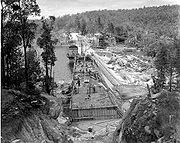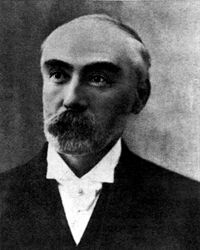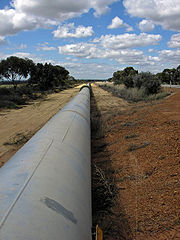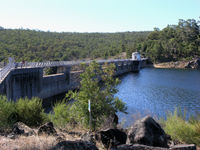
Goldfields Water Supply Scheme
Encyclopedia

Western Australia
Western Australia is a state of Australia, occupying the entire western third of the Australian continent. It is bounded by the Indian Ocean to the north and west, the Great Australian Bight and Indian Ocean to the south, the Northern Territory to the north-east and South Australia to the south-east...
's Eastern Goldfields
Eastern Goldfields
The Eastern Goldfields is a figurative area used in speech to describe a region of Western Australia.-Name:The name is derived in two parts from, Eastern in relation to its location from Perth and Goldfields as the name suggests comes from the mining of Gold in the region...
, particularly Coolgardie
Coolgardie, Western Australia
Coolgardie is a small town in the Australian state of Western Australia, east of the state capital, Perth. It has a population of approximately 800 people....
and Kalgoorlie
Kalgoorlie, Western Australia
Kalgoorlie, known as Kalgoorlie-Boulder, is a town in the Goldfields-Esperance region of Western Australia, and is located east-northeast of state capital Perth at the end of the Great Eastern Highway...
. The project was commissioned in 1896 and was completed in 1903.
During the early 1890s, thousands of settlers had swarmed into the barren and dry desert
Desert
A desert is a landscape or region that receives an extremely low amount of precipitation, less than enough to support growth of most plants. Most deserts have an average annual precipitation of less than...
centre of Western Australia in search of gold
Gold
Gold is a chemical element with the symbol Au and an atomic number of 79. Gold is a dense, soft, shiny, malleable and ductile metal. Pure gold has a bright yellow color and luster traditionally considered attractive, which it maintains without oxidizing in air or water. Chemically, gold is a...
, but existing infrastructure for the supply of water
Water
Water is a chemical substance with the chemical formula H2O. A water molecule contains one oxygen and two hydrogen atoms connected by covalent bonds. Water is a liquid at ambient conditions, but it often co-exists on Earth with its solid state, ice, and gaseous state . Water also exists in a...
was non-existent and an urgent need arose. The scheme enabled the benefits of the gold discovery to be realised and brought immense wealth into the previously struggling economy. Abundant water became available at a cost of three shillings and sixpence per thousand gallons, compared to water which had previously been carted by rail to Coolgardie previously at the rate of over £3 per thousand gallons. The position was even worse at Kalgoorlie.
The pipeline continues to operate today, supplying water to over 100,000 people in over 33,000 households as well as mines, farms and other enterprises.
Origins of the scheme
Throughout the 1890s, water availability issues in Coolgardie and in the Kalgoorlie - Boulder region were causing concern to the population. On 16 July 1896, the Premier of Western AustraliaPremier of Western Australia
The Premier of Western Australia is the head of the executive government in the Australian State of Western Australia. The Premier has similar functions in Western Australia to those performed by the Prime Minister of Australia at the national level, subject to the different Constitutions...
, Sir John Forrest
John Forrest
Sir John Forrest GCMG was an Australian explorer, the first Premier of Western Australia and a cabinet minister in Australia's first federal parliament....
introduced to Western Australian Parliament a bill
Bill (proposed law)
A bill is a proposed law under consideration by a legislature. A bill does not become law until it is passed by the legislature and, in most cases, approved by the executive. Once a bill has been enacted into law, it is called an act or a statute....
to authorise the raising of a loan of £2.5 million to construct the scheme: the pipeline would cart 23000 kilolitres (5,059,292.7 imp gal) of water per day to the Goldfields from a dam
Dam
A dam is a barrier that impounds water or underground streams. Dams generally serve the primary purpose of retaining water, while other structures such as floodgates or levees are used to manage or prevent water flow into specific land regions. Hydropower and pumped-storage hydroelectricity are...
on the Helena River
Helena River
The Helena River is a tributary of the Swan River in Western Australia. The river rises in country east of Mount Dale and moves to the north west to Mundaring Weir, where it is dammed...
near Mundaring Weir in Perth.
The scheme consisted of three key elements — the Mundaring Weir, which was fed with water from the Helena River
Helena River
The Helena River is a tributary of the Swan River in Western Australia. The river rises in country east of Mount Dale and moves to the north west to Mundaring Weir, where it is dammed...
in the Darling Scarp
Darling Scarp
The Darling Scarp, also referred to as the Darling Range or Darling Ranges, is a low escarpment running north-south to the east of the Swan Coastal Plain and Perth, Western Australia...
; a 760 millimetres (29.9 in) diameter steel
Steel
Steel is an alloy that consists mostly of iron and has a carbon content between 0.2% and 2.1% by weight, depending on the grade. Carbon is the most common alloying material for iron, but various other alloying elements are used, such as manganese, chromium, vanadium, and tungsten...
pipe
Water supply network
A water supply system or water supply network is a system of engineered hydrologic and hydraulic components which provide water supply. A water supply system typically includes:# A drainage basin ;...
which ran from the dam to Kalgoorlie 530 kilometres (329.3 mi) away; and a series of eight pumping stations and two small holding dams to control pressures and to lift the water over the Darling Scarp ridge.
Construction and criticism

C. Y. O'Connor
Charles Yelverton O'Connor CMG was an Irish engineer who is best-known for his work in Australia, especially the Goldfields Water Supply Scheme.-Early life:...
who oversaw its design and most of the construction project. Although supported by Premier Forrest, O'Connor had to deal with widespread criticism and derision from members of the Western Australian Parliament as well as the local press based on a belief that scope of the engineering task was too great and that it would never work. There was also a concern that the gold discoveries would soon dry up and the state would be left with a significant debt to repay but little or no commerce to support it.
Sunday Times
The Sunday Times (Western Australia)
The Sunday Times, owned by News Limited, is a tabloid Sunday newspaper printed in Perth and distributed throughout Western Australia.-History:...
editor Frederick Vosper
Frederick Vosper
Frederick Charles Burleigh Vosper was an Australian newspaper journalist and proprietor, and politician. He was well known for his ardent views and support of Australian republicanism, federalism and trade unionism.-Early life:...
- who was also a politician, ran a personal attack on O'Connor's integrity and ability through the paper. Timing was critical, Forrest as a supporter had moved into Federal politics, and the new Premier George Leake had long been an opponent of the scheme.
O'Connor committed suicide in March 1902 less than 12 months before the final commissioning of the pipeline.
Lady Forrest officially started the pumping machinery at Pumping Station number one on the 22 January, and on 24 January 1903 water flowed into the Mount Charlotte Reservoir at Kalgoorlie. O'Connors' engineer-in-chief, C. S. R. Palmer took over the project after his death, seeing it through to its successful completion.
The government conducted an inquiry into the scheme and found no basis for the press accusations of corruption or misdemeanours on the part of O'Connor.
Pipeline

Steel
Steel is an alloy that consists mostly of iron and has a carbon content between 0.2% and 2.1% by weight, depending on the grade. Carbon is the most common alloying material for iron, but various other alloying elements are used, such as manganese, chromium, vanadium, and tungsten...
sheets imported from Germany
Germany
Germany , officially the Federal Republic of Germany , is a federal parliamentary republic in Europe. The country consists of 16 states while the capital and largest city is Berlin. Germany covers an area of 357,021 km2 and has a largely temperate seasonal climate...
and the United States
United States
The United States of America is a federal constitutional republic comprising fifty states and a federal district...
. Mephan Ferguson
Mephan Ferguson
Mephan Ferguson was an Australian manufacturer, particularly of water supply pipes, notably for the pipleline to the Western Australian goldfields. He was born in Falkirk, Scotland. He immigrated with his parents to Melbourne in the colony of Victoria in Australia arriving in 1854...
was awarded the first manufacturing contract and built a fabrication plant at Falkirk (now known as the Perth suburb of Maylands
Maylands, Western Australia
Maylands is a suburb located approximately northeast of Perth centred on the Midland railway line and located on the northern bank of the Swan River....
) to produce half of the 60,000 pipes required. Hoskins Engineering established a factory near Midland Junction (now known simply as Midland
Midland, Western Australia
Midland is a suburb in the Perth, Western Australia metropolitan area, as well as the regional centre for the City of Swan local government area that covers the Swan Valley and parts of the Darling Scarp to the east. It is situated at the intersection of Great Eastern Highway and Great Northern...
) to produce the other half.
When built, the pipeline was the longest fresh-water pipeline in the world.
The choice of route for the Eastern Railway through Northam
Northam, Western Australia
Northam is a town in Western Australia, situated at the confluence of the Avon and Mortlock Rivers, about north-east of Perth in the Avon Valley. At the 2006 census, Northam had a population of 6,009. Northam is the largest town in the Avon region...
, rather than York
York, Western Australia
York is the oldest inland town in Western Australia, situated 97 km east of Perth in the Avon Valley near Northam, and is the seat of the Shire of York...
, is indicative of political patronage, as well as the avoidance of some other early routes to the goldfields. However, there is evidence that the explorer of the 1860s Charles Cooke Hunt
Charles Cooke Hunt
Charles Cooke Hunt was an explorer who led four expeditions into the interior of Western Australia between 1864 and 1866. He died in Geraldton....
had access to wells and tracks that were utilised in the 1890s. These subsequently affected the routes of telegraph, railway and the water scheme. The wells were made in conjunction with the local knowledge of aboriginals, and also utilised land at the edge of granite outcrops
Granite outcrops of Western Australia
Granite outcrops of Western Australia are inselbergs and monoliths made from granite that are found across much of Western Australia. Rising abruptly from the surrounding landscape they create a variety of microhabitats for plants, and provide seasonal resources and refuge for a range of animals....
.
The pipeline ran alongside the route of the earlier route of the Eastern Railway and the Eastern Goldfields Railway
Eastern Goldfields Railway
The Eastern Goldfields Railway was built in the 1880s to connect Perth, Western Australia with the rich goldfields at Coolgardie and Kalgoorlie. The narrow gauge Eastern Railway line already connected Perth with Northam, and the EGR extended this line through semi-desert to the goldfields...
's for parts of its route, so that the railway service and the pipeline had an interdependence through the sparsely populated wilderness.
The scheme required significant infrastructure in power generation to support the pumping stations. Communities oriented to its management grew up along the route. However, with improved power supplies and modern machinery and automation, the scheme now has more unattended pumping stations operated by fewer personnel.
Dam

Construction of the dam started in 1898. When completed in 1902 it was claimed to be the highest overflow dam in the world.
Shortly after World War II
World War II
World War II, or the Second World War , was a global conflict lasting from 1939 to 1945, involving most of the world's nations—including all of the great powers—eventually forming two opposing military alliances: the Allies and the Axis...
, the height of the dam wall was increased by 9.7 metres (31.8 ft).
Mundaring Weir Branch Railway
The Public Works Department originally constructed and ran the railway from the MundaringMundaring, Western Australia
Mundaring is a suburb located 34 km east of Perth on the Great Eastern Highway. The suburb is located within the Shire of Mundaring.The Aboriginal name of the area 'Mindah-lung', said to mean 'a high place on a high place', was anglicised to become 'Mundaring'.The Mundaring area is also considered...
railway station for the purpose of delivering materials to the construction site. The Western Australian Government Railways
Western Australian Government Railways
Western Australian Government Railways was most common name of the Western Australian government rail transport authority from 1890 to 1976. It is, in its current form, known as the Public Transport Authority of Western Australia....
took over the railway operation. It ceased operation in 1952, and the connecting railway line at Mundaring closed in 1954.
Design challenges
- The sudden Darling Range height rise between Mundaring and Northam required the location of Pumping Station number two to be close to number one
- The Avon River in Northam required the construction of the Poole Street Bridge after failure of river bed pipes in 1917
The distance was compounded by the height the water had to be lifted. To rise the almost 400 metres (1,312.3 ft) in altitude, issues with friction meant that the 'head' of 800 metres (2,624.7 ft) had to be achieved. O'Connor had eight pumping stations which pumped the water to the next of the receiving tanks in his plans.
By the early 1930s, 1700000 kilolitres (373,947,722.1 imp gal) of water per year - a quarter of the total volume of water being pumped from Mundaring Weir - was leaking from the pipeline.
Pumping stations

To enhance the reliability of the system, each pumping station was designed and constructed with a spare
Redundancy (engineering)
In engineering, redundancy is the duplication of critical components or functions of a system with the intention of increasing reliability of the system, usually in the case of a backup or fail-safe....
pumping unit. Due to pressure requirements related to the slope of the pipeline, stations one to four required two pumping units to be in operation. Stations five to eight only required one operating pump, due to a lower rise in height between those stations.
James Simpson and Co supplied 3,500 tonnes of equipment in 5,000 separate boxes for the construction of the pumping sets.
Original pumping stations
- Number One - below Mundaring Weir (now a National Trust administered museum)
- Number Two - above Mundaring Weir (demolished in 1960s)
- Number Three - CunderdinCunderdin, Western AustraliaCunderdin is a town located in the Wheatbelt region of Western Australia 156 km east of Perth, on Great Eastern Highway.- History :The first European visitor to the area was Charles Cooke Hunt, who explored the area in 1864 and recorded the name Cunderdin, from the Aboriginal name of a nearby...
(now Cunderdin Museum) - Number Four - MerredinMerredin, Western Australia-Economy:The agricultural land around Merredin produces 40% of Western Australia’s wheat quota. As a focal point for the region, Merredin’s local bulk handling co-operative receives and processes in excess of a million tonnes of grain every year...
(location of three generations of pump station) - Number Five - Yerbillon
- Number Six - Ghouli
- Number Seven - Gilgai
- Number Eight - Dedari
Current pumping stations
Branch mains - or extensions were started as early as 1907.
Water from the pipeline was utilised for a number of country towns adjacent to its route, and also into the Great Southern region
Great Southern region of Western Australia
The Great Southern region is one of the nine regions of Western Australia. It is a section of the larger South Coast of Western Australia and neighbouring agricultural regions....
. The Public Works Department started this project in the 1950s following the raising of the weir wall in the early 1950s and it completed this work in 1961.
Centenary
The scheme was 'interpreted' by the National Trust of AustraliaNational Trust of Australia
The Australian Council of National Trusts is the peak body for community-based, non-government organisations committed to promoting and conserving Australia's indigenous, natural and historic heritage....
(WA) in its Golden Pipeline Project
Golden Pipeline Project
Golden Pipeline Project was a project conducted by the National Trust of Australia which created guide books, web sites, and tourist trails along the Goldfields Water Supply Scheme pipeline at the time the pipeline was being celebrated for its 100 years of operation...
which created guide books, web sites, and tourist trails along the scheme pipeline and tracing the older Power Station locations and communities that serviced the scheme. The Trust achieved the responsibility in an agreement with the Water Corporation
Water Corporation
-Overview:The Water Corporation is the principal supplier of water, wastewater and drainage services throughout the state of Western Australia...
in 1998. Most of the material was developed between 2001 and 2003.
Lower Helena Dam
Lower Helena Pumpback dam is now also used to supply water to the Goldfields region. Water from the dam is currently pumped back into Mundaring Weir. Helena pumpstation is proposed to supply water directly into the goldfields pipeline without the need to pump into Mundaring Weir.See also
- Kalgoorlie, Western AustraliaKalgoorlie, Western AustraliaKalgoorlie, known as Kalgoorlie-Boulder, is a town in the Goldfields-Esperance region of Western Australia, and is located east-northeast of state capital Perth at the end of the Great Eastern Highway...
- Pipeline transportPipeline transportPipeline transport is the transportation of goods through a pipe. Most commonly, liquids and gases are sent, but pneumatic tubes that transport solid capsules using compressed air are also used....
- Water supply networkWater supply networkA water supply system or water supply network is a system of engineered hydrologic and hydraulic components which provide water supply. A water supply system typically includes:# A drainage basin ;...
- C.Y. O'Connor
External links
- The Golden Pipeline Project
- The WA National Trust Website
- Serle, Percival (1949). “O'Connor, Charles”, Dictionary of Australian Biography. Sydney: Angus and Robertson.

